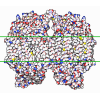[English] 日本語
 Yorodumi
Yorodumi- PDB-6koe: X-ray Structure of the proton-pumping cytochrome aa3-600 menaquin... -
+ Open data
Open data
- Basic information
Basic information
| Entry | Database: PDB / ID: 6koe | ||||||
|---|---|---|---|---|---|---|---|
| Title | X-ray Structure of the proton-pumping cytochrome aa3-600 menaquinol oxidase from Bacillus subtilis | ||||||
 Components Components |
| ||||||
 Keywords Keywords | OXIDOREDUCTASE / Menaquinol oxidase / Complex / Proton pumping / inhibitor | ||||||
| Function / homology |  Function and homology information Function and homology informationOxidoreductases; Acting on diphenols and related substances as donors; With oxygen as acceptor / cytochrome o ubiquinol oxidase complex / cytochrome bo3 ubiquinol oxidase activity / aerobic electron transport chain / respiratory chain complex / oxidoreductase activity, acting on diphenols and related substances as donors, oxygen as acceptor / oxidative phosphorylation / cytochrome-c oxidase activity / electron transport coupled proton transport / proton transmembrane transporter activity ...Oxidoreductases; Acting on diphenols and related substances as donors; With oxygen as acceptor / cytochrome o ubiquinol oxidase complex / cytochrome bo3 ubiquinol oxidase activity / aerobic electron transport chain / respiratory chain complex / oxidoreductase activity, acting on diphenols and related substances as donors, oxygen as acceptor / oxidative phosphorylation / cytochrome-c oxidase activity / electron transport coupled proton transport / proton transmembrane transporter activity / ATP synthesis coupled electron transport / aerobic respiration / respiratory electron transport chain / membrane raft / copper ion binding / heme binding / plasma membrane Similarity search - Function | ||||||
| Biological species |  | ||||||
| Method |  X-RAY DIFFRACTION / X-RAY DIFFRACTION /  SYNCHROTRON / SYNCHROTRON /  MOLECULAR REPLACEMENT / Resolution: 3.75 Å MOLECULAR REPLACEMENT / Resolution: 3.75 Å | ||||||
 Authors Authors | Xu, J. / Ding, Z. / Liu, B. / Li, J. / Gennis, R.B. / Zhu, J. | ||||||
 Citation Citation |  Journal: Proc.Natl.Acad.Sci.USA / Year: 2020 Journal: Proc.Natl.Acad.Sci.USA / Year: 2020Title: Structure of the cytochromeaa3-600 heme-copper menaquinol oxidase bound to inhibitor HQNO shows TM0 is part of the quinol binding site. Authors: Xu, J. / Ding, Z. / Liu, B. / Yi, S.M. / Li, J. / Zhang, Z. / Liu, Y. / Li, J. / Liu, L. / Zhou, A. / Gennis, R.B. / Zhu, J. | ||||||
| History |
|
- Structure visualization
Structure visualization
| Structure viewer | Molecule:  Molmil Molmil Jmol/JSmol Jmol/JSmol |
|---|
- Downloads & links
Downloads & links
- Download
Download
| PDBx/mmCIF format |  6koe.cif.gz 6koe.cif.gz | 965.7 KB | Display |  PDBx/mmCIF format PDBx/mmCIF format |
|---|---|---|---|---|
| PDB format |  pdb6koe.ent.gz pdb6koe.ent.gz | 771.8 KB | Display |  PDB format PDB format |
| PDBx/mmJSON format |  6koe.json.gz 6koe.json.gz | Tree view |  PDBx/mmJSON format PDBx/mmJSON format | |
| Others |  Other downloads Other downloads |
-Validation report
| Summary document |  6koe_validation.pdf.gz 6koe_validation.pdf.gz | 1.6 MB | Display |  wwPDB validaton report wwPDB validaton report |
|---|---|---|---|---|
| Full document |  6koe_full_validation.pdf.gz 6koe_full_validation.pdf.gz | 1.7 MB | Display | |
| Data in XML |  6koe_validation.xml.gz 6koe_validation.xml.gz | 84.4 KB | Display | |
| Data in CIF |  6koe_validation.cif.gz 6koe_validation.cif.gz | 110.5 KB | Display | |
| Arichive directory |  https://data.pdbj.org/pub/pdb/validation_reports/ko/6koe https://data.pdbj.org/pub/pdb/validation_reports/ko/6koe ftp://data.pdbj.org/pub/pdb/validation_reports/ko/6koe ftp://data.pdbj.org/pub/pdb/validation_reports/ko/6koe | HTTPS FTP |
-Related structure data
| Related structure data | 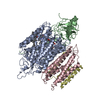 6kobC 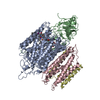 6kocC 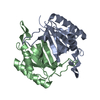 3kocS C: citing same article ( S: Starting model for refinement |
|---|---|
| Similar structure data |
- Links
Links
- Assembly
Assembly
| Deposited unit | 
| ||||||||||
|---|---|---|---|---|---|---|---|---|---|---|---|
| 1 | 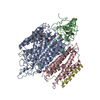
| ||||||||||
| 2 | 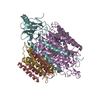
| ||||||||||
| Unit cell |
|
- Components
Components
-AA3-600 quinol oxidase subunit ... , 3 types, 6 molecules AECGDH
| #1: Protein | Mass: 74721.688 Da / Num. of mol.: 2 Source method: isolated from a genetically manipulated source Source: (gene. exp.)  Gene: qoxB, B4122_4931, B4417_2140, ETA10_20065, ETK61_21170, ETL41_11350, SC09_contig4orf01211 Production host:  #3: Protein | Mass: 22689.572 Da / Num. of mol.: 2 Source method: isolated from a genetically manipulated source Source: (gene. exp.)  Gene: B4122_4930, B4417_2139, ETA10_20060, ETK61_21165, ETL41_11345, SC09_contig4orf01209 Production host:  #4: Protein | Mass: 12404.315 Da / Num. of mol.: 2 Source method: isolated from a genetically manipulated source Source: (gene. exp.)   |
|---|
-Protein , 1 types, 2 molecules BF
| #2: Protein | Mass: 33589.961 Da / Num. of mol.: 2 Source method: isolated from a genetically manipulated source Source: (gene. exp.)   References: UniProt: A0A2I7T8S1, UniProt: P34957*PLUS, Oxidoreductases; Acting on diphenols and related substances as donors; With oxygen as acceptor |
|---|
-Non-polymers , 3 types, 8 molecules 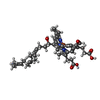




| #5: Chemical | ChemComp-HEA / #6: Chemical | #7: Chemical | |
|---|
-Details
| Has ligand of interest | N |
|---|---|
| Sequence details | Authors know the sequence of chain D/H, but they are not sure of the alignment for first 22 ...Authors know the sequence of chain D/H, but they are not sure of the alignment for first 22 residues in the coordinates. The residue numbers 0-21 in the coordinates may be meaningless. The correct sequence is MANKSAEHSH |
-Experimental details
-Experiment
| Experiment | Method:  X-RAY DIFFRACTION / Number of used crystals: 1 X-RAY DIFFRACTION / Number of used crystals: 1 |
|---|
- Sample preparation
Sample preparation
| Crystal | Density Matthews: 4.5 Å3/Da / Density % sol: 76.21 % |
|---|---|
| Crystal grow | Temperature: 295 K / Method: vapor diffusion, sitting drop / pH: 6.3 Details: 0.1 M Calcium chloride, 0.1M Tris pH 6.3, 13% PEG 2000 MME |
-Data collection
| Diffraction | Mean temperature: 100 K / Serial crystal experiment: N |
|---|---|
| Diffraction source | Source:  SYNCHROTRON / Site: SYNCHROTRON / Site:  SSRF SSRF  / Beamline: BL17U1 / Wavelength: 0.9793 Å / Beamline: BL17U1 / Wavelength: 0.9793 Å |
| Detector | Type: DECTRIS PILATUS3 6M / Detector: PIXEL / Date: Nov 26, 2018 |
| Radiation | Protocol: SINGLE WAVELENGTH / Monochromatic (M) / Laue (L): M / Scattering type: x-ray |
| Radiation wavelength | Wavelength: 0.9793 Å / Relative weight: 1 |
| Reflection | Resolution: 3.75→49.252 Å / Num. obs: 52047 / % possible obs: 99.5 % / Redundancy: 3 % / CC1/2: 0.854 / Rmerge(I) obs: 0.227 / Net I/σ(I): 3.9 |
| Reflection shell | Resolution: 3.75→3.87 Å / Rmerge(I) obs: 1.337 / Num. unique obs: 4517 / CC1/2: 0.437 |
- Processing
Processing
| Software |
| ||||||||||||||||||||||||||||||||||||||||
|---|---|---|---|---|---|---|---|---|---|---|---|---|---|---|---|---|---|---|---|---|---|---|---|---|---|---|---|---|---|---|---|---|---|---|---|---|---|---|---|---|---|
| Refinement | Method to determine structure:  MOLECULAR REPLACEMENT MOLECULAR REPLACEMENTStarting model: 3KOC Resolution: 3.75→49.252 Å / Cross valid method: FREE R-VALUE
| ||||||||||||||||||||||||||||||||||||||||
| Refinement step | Cycle: LAST / Resolution: 3.75→49.252 Å
| ||||||||||||||||||||||||||||||||||||||||
| LS refinement shell | Resolution: 3.7501→3.8438 Å
| ||||||||||||||||||||||||||||||||||||||||
| Refinement TLS params. | Method: refined / Origin x: -24.7074 Å / Origin y: 4.8848 Å / Origin z: -12.8379 Å
| ||||||||||||||||||||||||||||||||||||||||
| Refinement TLS group | Selection details: all |
 Movie
Movie Controller
Controller



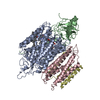
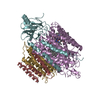
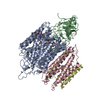
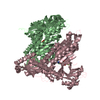



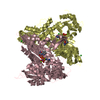

 PDBj
PDBj